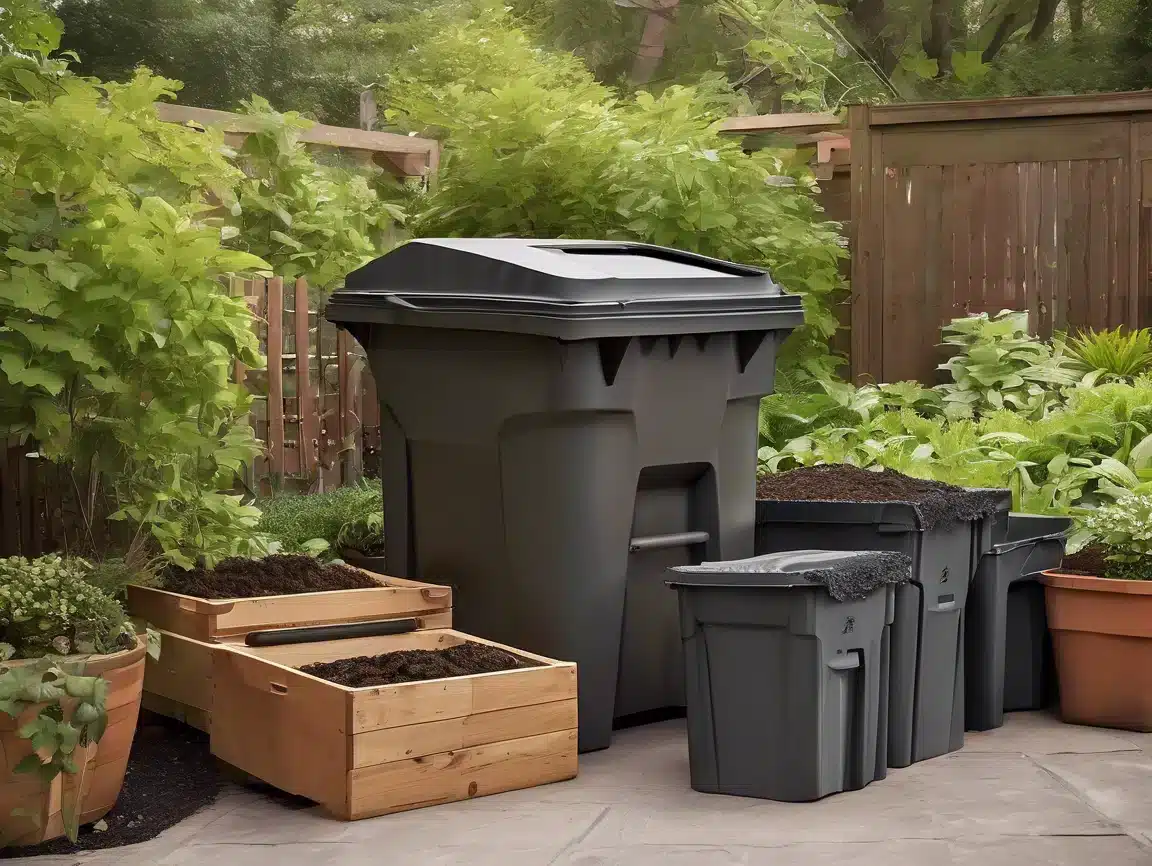Quick Overview – Lomi and Foodcycler at a Glance
In recent years, the demand for effective home composting solutions has surged, leading to the development of innovative electric composters like Lomi and Foodcycler. Both devices aim to simplify the composting process by enabling users to recycle organic waste conveniently and efficiently within their own homes.
Lomi is designed with user-friendliness in mind, offering a sleek and compact design that fits easily into various kitchen spaces. It utilizes advanced technology to break down food scraps, yard waste, and even compostable bioplastics in as little as 24 hours. Key features include a multi-stage process that employs heat, aeration, and grinding mechanisms to accelerate decomposition. With the integration of smart features, users can monitor the composting process through a dedicated app, making it easier to manage their composting efforts.
On the other hand, Foodcycler also stands out with its efficient design aimed at reducing food waste. Its compact footprint makes it suitable for urban environments, while its operation is relatively quiet compared to other models. Foodcycler processes organic waste into nutrient-rich compost within approximately 3 hours, making it a fast choice for users. It boasts a simple one-button operation, ensuring ease of use for individuals with varying levels of composting experience. Furthermore, Foodcycler produces little to no odor during the composting process, enabling users to utilize it in their kitchens without concerns about unpleasant smells.
For those interested in a more detailed understanding of each device, we recommend checking our comprehensive reviews on Lomi and Foodcycler. These reviews delve deeper into the features, benefits, and potential drawbacks of each electric composter, aiding readers in making a well-informed decision based on their specific composting needs.
Best Home Composting Solutions for 2025 – click here
Design Aspects of Lomi and Foodcycler
The design of an electric composter is crucial in determining its usability and overall appeal. Both Lomi and Foodcycler present unique design elements that cater to different consumer preferences and requirements. Lomi is characterized by its compact, modern design, which easily integrates into various kitchen décors. It is relatively lightweight and portable, making it suitable for users who may wish to move it to different locations within their homes. The outer casing is crafted from durable materials that not only enhance its aesthetic appeal but also ensure longevity. The user-friendly interface features intuitive controls, allowing individuals of all technological skill levels to operate it without complication.
On the other hand, Foodcycler offers a slightly bulkier appearance but compensates for this with a robust build quality. Its design reflects its functional purpose, emphasizing efficiency and practicality over minimalist aesthetics. The materials used in the Foodcycler are designed for durability, promising to withstand extensive use. Notably, it incorporates a larger capacity, making it ideal for families or individuals with substantial food scraps. This aspect significantly influences its overall composting experience, as users can process larger quantities in each cycle. Moreover, the slightly intricate control panel may require a learning curve for some users, which could impact its immediate usability.
In evaluating the user-friendliness of both electric composters, Lomi’s simplistic and modern interface stands out, enabling swift and easy operations. Conversely, while Foodcycler’s larger capacity is advantageous, its complexities may deter those who prefer a straightforward composting process. Overall, design plays a pivotal role in the effectiveness and appeal of both Lomi and Foodcycler, influencing customer choices based on aesthetic preferences, size, and user experience.
Functionality
The operational mechanics of electric composters like Lomi and Foodcycler reveal significant distinctions in how they handle organic waste. Both devices serve the purpose of transforming food scraps and biodegradable materials into nutrient-rich compost, but their methods and features differ in various ways.
Lomi Composter
Lomi’s multi-functional operation speeds up composting by integrating grinding, oxygen infusion, and temperature regulation. It can handle a wide range of organic matter, including fruits, vegetables, and certain animal products. The device offers different settings that optimize the composting process based on the type of waste being processed. For example, it has modes for quick compost in as little as 24 hours, ideal for households aiming for rapid waste reduction. Users may appreciate Lomi’s compact design, which allows for easy integration into kitchen spaces.
Food Cycler Composter
On the other hand, Foodcycler utilizes a dehydration method before grinding the organic material, resulting in a dry, crumbly end product. This process typically takes longer, approximately three to eight hours, depending on the volume of waste. Foodcycler is optimized for specific types of organic materials, particularly those that have a higher moisture content. It features a clean-and-easy design, reducing the hassle of cleaning up after use. However, it lacks the flexibility in processing different waste types that Lomi boasts.
Both devices excel in convenience and efficiency, but the final choice largely depends on specific user needs. Lomi offers rapid composting with variable functionalities to address diverse waste materials, while Foodcycler provides a streamlined method focused on moisture-rich waste. Therefore, potential buyers should weigh the importance of speed versus the kind of organic waste they typically dispose of when selecting the right electric composter for their needs.
Capacity and Performance
When evaluating electric composters, one crucial aspect is their composting capacity, which refers to the volume of organic waste each device can process at once. The Lomi composter typically accommodates around 5 liters of organic waste, making it suitable for small households or individuals that produce a moderate amount of kitchen scraps. On the other hand, the Foodcycler offers a slightly greater capacity, able to handle up to 8 liters of organic material. This heightened capacity makes the Foodcycler a more favorable option for larger families or those who regularly work with extensive food preparation, resulting in increased organic waste.
Performance is another critical factor in the comparison between Lomi and Foodcycler. Both devices employ unique technologies to accelerate the decomposition process, but they demonstrate differences in efficiency based on the types of organic materials introduced. The Lomi device is known for its versatility, efficiently breaking down fruit and vegetable peels, coffee grounds, and even small amounts of meat and dairy. Thus, it is particularly advantageous for diverse kitchen waste management. Conversely, the Foodcycler excels in handling high volumes of fruit and vegetable scraps, which contribute to rapid decomposition; however, it is generally advised to limit the addition of meat and dairy products to maintain optimal performance and odor control.
In summary, when selecting an electric composter, one must consider both the capacity and performance to ensure it aligns with their composting needs. The Foodcycler is ideal for households with considerable organic waste due to its superior capacity, whereas the Lomi provides more versatile applicability for various waste types. Therefore, understanding individual requirements will help in determining the most suitable option between these two compelling models.
Ease of Use
The user-friendliness of electric composters plays a pivotal role in determining their appeal to consumers, especially for those who are new to composting. When evaluating the ease of use for both the Lomi and the Foodcycler, several factors come into play: setup process, operating complexity, and maintenance requirements.
Starting with the setup, the Lomi composter is designed with the intention of providing a seamless experience. Users typically report that it requires minimal assembly; the package includes straightforward instructions, making it accessible for beginners. Once plugged in, users can easily navigate the device through its simple interface, which allows for quick selection of settings based on the type of waste being composted. This promotes an intuitive operation, catering to new users while still providing enough advanced features for seasoned composters.
Comparatively, the Foodcycler also offers an effortless setup experience. Similar to the Lomi, it requires minimal assembly and comes with clear user instructions. However, its control panel may pose slightly more complexity for novice users. While the Foodcycler has a user-friendly operating system, its varied cycle settings can be overwhelming for those unfamiliar with composting technology. Nevertheless, experienced users tend to appreciate the versatility that these options provide.
In terms of maintenance, both models are relatively low-maintenance, but they have different requirements. The Lomi necessitates occasional cleaning of its internal components, which can be accomplished with simple household items. The Foodcycler, on the other hand, does have a removable bucket, which simplifies the cleaning process and is conducive for regular usage. For individuals who prefer less upkeep, this design may be more appealing.
Ultimately, both the Lomi and the Foodcycler present valuable advantages in usability, making them capable options for both beginners and experienced users. The choice between the two may ultimately hinge on personal preferences regarding features and the desired level of involvement in the composting process.
Environmental Impact
The environmental benefits of utilizing electric composters, such as Lomi and Foodcycler, are significant in the context of contemporary waste management practices. Both devices serve as alternatives to traditional composting methods, allowing for more efficient decomposition of organic materials, particularly food waste. The global impact of food waste is alarming, with approximately one-third of all food produced being wasted, contributing to greenhouse gas emissions as it decomposes in landfills.
Lomi and Foodcycler tackle this issue head-on, transforming food scraps into nutrient-rich compost within a matter of hours. Specifically, Lomi’s innovative technology breaks down food waste at a molecular level, resulting in a biodegradable product that can be used in gardens or houseplants. This quick conversion not only keeps waste out of landfills but also cuts down on methane released from decaying organic matter. Foodcycler, similarly, employs a unique heating and grinding mechanism to efficiently reduce food waste volume and promote accelerated composting.
Energy consumption is another crucial aspect of these electric composters. While both devices require electricity to operate, they are designed to be energy-efficient. For instance, Lomi operates on less energy than a standard household appliance, making it a sustainable choice for eco-conscious consumers. Foodcycler, too, has optimally designed cycles that allow for minimal energy use while maximizing output. Therefore, the overall sustainability of Lomi and Foodcycler lies not only in their ability to reduce food waste but also in their comparatively low energy requirements.
In essence, both Lomi and Foodcycler demonstrate a commitment to environmental stewardship. Their innovative approaches to composting provide effective solutions to food waste challenges while promoting sustainability and energy efficiency. By choosing electric composters, individuals can significantly lessen their ecological footprint, contributing positively to a healthier planet.
Price Comparison
When evaluating the costs associated with electric composters, Lomi and Foodcycler present distinct financial implications that potential buyers should consider. The initial purchase price of each unit can significantly influence decision-making, with Lomi typically priced around $499, while Foodcycler units usually range from $300 to $400. These price points reflect the different features and technologies utilized by both composters, which cater to diverse consumer needs.
Beyond the upfront costs, it is essential to examine potential long-term savings tied to composting. Lomi and Foodcycler both work to decrease organic waste, thereby lowering the amount sent to landfills. While direct savings may vary based on local waste disposal fees, homeowners can anticipate decreased expenses related to garbage pickup. Moreover, compost sustains valuable nutrients for home gardens, reducing the need for store-bought fertilizers and soil enhancers, thereby delivering ongoing financial benefits.
Additionally, ongoing costs such as energy consumption are vital when weighing these two options. Both Lomi and Foodcycler are designed for energy efficiency, but operational costs may fluctuate based on usage frequency. Lomi claims a power consumption rate of approximately 0.5 kWh per cycle, making it relatively economical for regular home use. Conversely, Foodcycler operates at about 0.38 kWh, presenting a marginally lower energy expenditure during its cycles. These differences, though minor, can accumulate over time, impacting the overall affordability of either composter.
Lastly, maintenance costs should also be accounted for, as both units feature simple components that generally require little upkeep. However, Lomi often touts its ease of cleaning as a selling point, which could indirectly influence user satisfaction and long-term usability. In summary, evaluating pricing involves not merely the initial investment but also the long-term financial implications tied to energy usage, maintenance, and the intrinsic savings from effective composting practices.
Customer Reviews and Feedback
The evaluation of customer reviews and feedback is an essential aspect of understanding the practical usability and reliability of electric composters, specifically Lomi and Foodcycler. A comprehensive analysis of user experiences reveals a variety of opinions that highlight both strengths and weaknesses of each product.
Beginning with Lomi, many users appreciate its compact design and efficiency in processing kitchen waste. Customers often praise Lomi for its ability to break down organic materials quickly, with some reviewers noting that it can convert food scraps into compost within hours. The ease of use is frequently mentioned, as the straightforward controls allow users to start the composting process with minimal hassle. However, there are some recurring complaints about the product’s odor control. A number of users report that while Lomi performs well, it occasionally emits unpleasant smells during operation, which can be a deterrent for indoor use.
On the other hand, the Foodcycler has received positive feedback for its larger capacity, making it suitable for families or households with greater waste production. Users highlight its effectiveness in reducing waste volume significantly, and many express satisfaction with the quality of compost produced. Nevertheless, some customers point out that the Foodcycler can be relatively noisy during operation, and a few have experienced issues with the device’s durability over time, citing failures in the unit’s components. One common sentiment among buyers of both electric composters is that they appreciate the environmental benefits of composting and the convenience that these products offer in reducing kitchen waste.
Overall, customer feedback for both Lomi and Foodcycler presents a mixed yet informative perspective. By considering these insights, potential buyers can make more informed decisions based on real-world usage and outcomes associated with each composter.
Conclusion and Recommendation
In the analysis of Lomi and Foodcycler, two prominent electric composters, several key factors emerge that can guide potential buyers in making an informed decision. Both units are designed to simplify the composting process and minimize kitchen waste, but they cater to different user preferences and needs.
The Lomi composter stands out with its sleek design and user-friendly interface, making it an ideal choice for those who appreciate aesthetics alongside functionality. It features multiple modes for composting, including a rapid cycle that can handle not just kitchen scraps but also packaging waste like bioplastics. However, its price point tends to be higher, which may deter budget-conscious consumers. User feedback indicates a high level of satisfaction for those who prioritize quick composting and multifunctionality.
On the other hand, the Foodcycler offers a more budget-friendly option while still delivering satisfactory composting results. It excels in processing organic waste effectively, turning it into usable fertilizer in a matter of hours. However, its design is more utilitarian than visually appealing, which might not be an attractive feature for every consumer. According to user reviews, the Foodcycler is appreciated for its reliability and its efficiency in handling food scraps, making it a strong contender for environmentally conscious individuals seeking value.
Ultimately, the decision between Lomi and Foodcycler should be based on individual needs. Those seeking an aesthetically pleasing, multifunctional composter may prefer Lomi, while those looking for a simpler, cost-effective solution might find the Foodcycler to be a better fit. Considering these factors will help consumers choose the electric composter that aligns with their lifestyle and composting goals.
“Need help deciding which compost bin suits your space and smell tolerance? Don’t miss our Ultimate Guide to choosing the right compost bin.”


